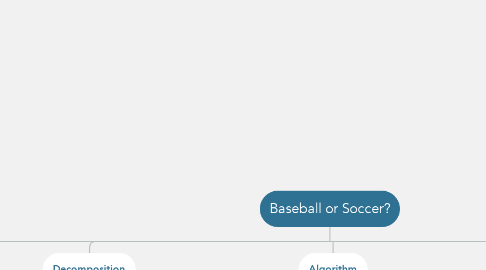
1. Problem
1.1. Thomas enjoys playing sports and he is trying to figure out which sport is best for the spring season. His first love is baseball, but soccer has suddenly peaked his interests. His problem is should he play baseball or soccer?
2. Algorithm
2.1. Then Thomas develops an algorithm to solve his problem step-by-step. First, he looks in the garage for equipment to see what he already has. Then he makes a list of equipment needed. Next, he estimates the cost for new equipment and fees for playing baseball or soccer. Then Thomas writes out pros and cons for each sport, including his skill level. Then he goes outside to try each sport and see how he feels about the choice. Last, Thomas talks to his parents to see their opinion and makes them promise not to be "those sports parents" at the games.
2.1.1. Creating an algorithm is the third step, in which a series of step-by-step instructions are created for solving the problem (Google Computational Thinking for Educators, n.d.). In this example, Thomas creates steps to make sense of his research and solve his problem systematically.
3. Abstraction
3.1. Thomas ends up choosing the competitive baseball league and trying soccer in a rec league. He learns that all sports are a commitment, time-consuming, and costly. He also learned that sports are fun, and he will get to spend time with his friends. Also, Thomas learns that there was no possible way for his parents to be calm in the crowd. They will always be wildly cheering him on. Maybe next year, he will try chess!
3.1.1. Abstraction is the final piece in Computational Thinking. In this example, Thomas creates conclusions or general principles based on the patterns and algorithms in his research (Google Computational Thinking for Educators, n.d.). This is the part where Thomas brings together all of the research to solve his problem and make conclusions for the future.
4. Decomposition
4.1. Thomas needs to decompose the problem and break it into parts. First, he must find out general information for each sport. Then he searches the city sports website to find out more about the season, the costs, and equipment required. Then Thomas searches to find more information about practices and games. Lastly and just for fun, he searches which sport is least likely to make his parents go crazy.
4.1.1. Thomas decides to use Computational Thinking (CT), a problem solving process, (Google Computational Thinking for Educators, n.d.) to solve his problem. The first step is decomposition. According to Yadav, Hing, and Stephenson (2016), decomposition is "breaking down complex problems into more familiar/manageable sub-problems." In this example, Thomas breaks his problem down into smaller pieces, so that can he figure out what each sport involves and then solve his problem. Using the smaller parts, made Thomas feel less overwhelmed. Each part will help him to solve the original problem.
4.1.2. Pattern Recognition
4.1.2.1. As Thomas learns about each sport, he identifies the ways the sports are different and the commonalities (patterns} of each sport. Also, he realizes that both require new equipment, use balls, and are team sports. He also realizes that both are outdoors, in the hot or cold weather. Thomas sees that both have practices and games during the week and on the weekends, and sometimes have tournaments, too. Both have fees to play, a chance to hang out with his friends, are fun, and are good exercise. He found that both sports have competitive and rec leagues. Thomas also found that both sports have the same potential for crazy fans and parents.
4.1.2.1.1. Pattern recognition is "observing patterns, trends, and regularities in data" (Google Computational Thinking for Educators, n.d.), Thomas researched more and found the many similarities between baseball and soccer. He found things he liked about both sports.

